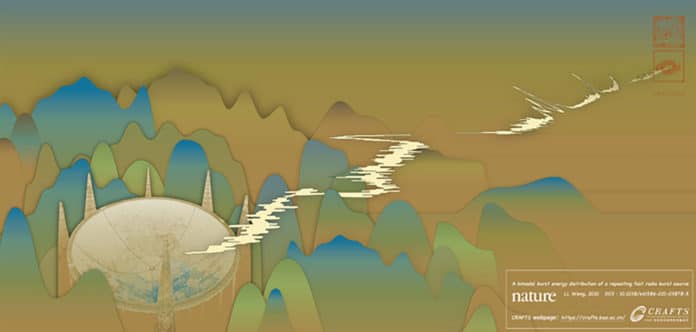An international team of astronomers reported that more than 1,650 fast radio bursts (FRBs) originated from a single source in space. These independent Fast Radio Bursts are coming from the source over 47 days, making them the largest-ever observed set of FRBs.
Using the Five-hundred-meter Aperture Spherical Telescope (FAST) in China, the team identified the source of the phenomena. The original FRB 121102 represents more FRBs in one event than all previously reported occurrences combined.
UNLV astrophysicist Bing Zhang said, “The signals were recorded from one source over 47 days in 2019. This was the first time that one FRB source was studied in such great detail. The large burst set helped our team hone in like never before on the characteristic energy and energy distribution of FRBs, which sheds new light on the engine that powers these mysterious phenomena.”
FRB 121102 is thought to be co-located in a dwarf galaxy about three billion light-years from Earth with a low-luminosity active galactic nucleus, a previously unknown type of extragalactic source, or a previously unknown type of extragalactic source young neutron star energizing a supernova remnant. The radio bursts coming from the source are 500 times more polarized than those from any other FRB to date.
Zhang said, “These results pose great challenges to the latter model. The bursts are too frequent, and – given that this episode alone amounts to 3.8% of the energy available from a magnetar – it adds up to too much energy for the second model to work.”
Pei Wang, one of the article’s lead authors from the National Astronomical Observatories of the Chinese Academy of Sciences (NAOC), said, “During its most active phase, FRB 121102 included 122 bursts measured within one hour, the highest repeat rate ever observed for any FRB.”
According to scientists, “FAST will continue to systematically investigate a large number of repeating FRBs in the future.”
Di Li, the study’s lead researcher from NAOC, said, “As the world’s largest antenna, FAST’s sensitivity proves to be conducive to revealing intricacies of cosmic transients, including FRBs.”
Journal Reference:
- Li, D., Wang, P., Zhu, W.W. et al. A bimodal burst energy distribution of a repeating fast radio burst source. Nature 598, 267–271 (2021). DOI: 10.1038/s41586-021-03878-5
